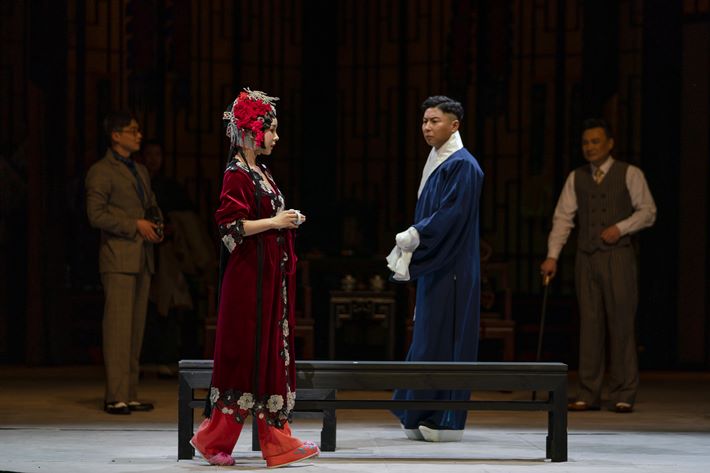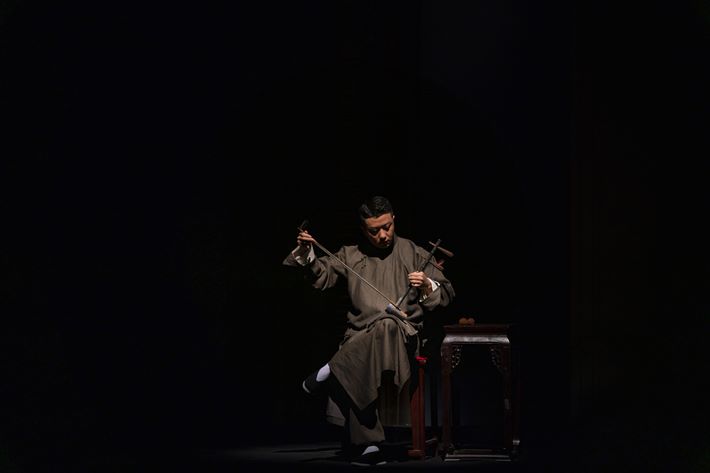Yan Rui: Birth of a New Genre

As the lights come up, the backdrop, tables, chairs, screens, plaques and other props of the Peking Opera show set a relatively specific scene. The stage begins to rotate slowly, and the troupe hidden behind the set is moved to center stage. The whole stage is an opera within a play. The lead character, Peking Opera artist Liu Zhensheng, marches to the only seat on the stage to perform his climactic finish.

In the first act of the drama The Death of a Star, Liu Zhensheng, who is applying makeup in preparation to go on stage, suddenly steps forward to stop his disciple Liu Fengxian from following Uncle Yang. Liu Zhensheng and Liu Fengxian circle the stage in slow motion without speaking, which cleverly renders their emotions using traditional methods. by Guo Shasha/China Pictorial
It is the last scene in The Death of a Star, a new three-act classical drama produced by Beijing People’s Art Theater. The drama enjoyed a second run from January 12 to 21, 2021, at Capital Theater. “The set design captures a fusion of the impressionistic style of traditional Eastern opera and the realism of Western drama,” commented Yan Rui, co-director of the drama and a young artist from Beijing People’s Art Theater.

In the third act of the drama The Death of a Star, Liu Fengxian chooses to follow Uncle Yang again before her final departure from the stage. She and Liu Zhensheng again slowly circle the stage as she dresses in a costume, takes off the costume, and throws the pieces to the ground. The sequence is layered and superimposed progressively, rising to the climax of the character’s psychology and the dramatic plot. by Guo Shasha/China Pictorial
The Death of a Star tells the story of Liu Zhensheng, a fictional Peking Opera master during the early years of the Republic of China period (1912-1949). When Liu Fengxian, Liu Zhensheng’s disciple in whom he has invested great expectations, is seduced by the promise of fame and fortune from Shanghai Bund bully Uncle Yang, two different ideals collide fiercely in Liu Zhensheng’s heart: “to live to act” or “to act to live.” Endeavoring to further the art until his final breath, Liu Zhensheng collapses on the stage he had graced most of his life.

A still from the premiere of The Death of a Star. by Guo Shasha/China Pictorial
The drama seeks to capture the joy and sorrow in traditional operatic circles. The show’s ingenious fusion of Peking Opera and Western drama attracted huge attention after its premiere in 2018. The show deployed dramatic narrative methodology to present the core story of Peking Opera. The formal beauty of traditional art and the themes of the drama support and sublimate each other, creating an entirely new stage style. “The whole drama revolves around stories related to the Peking Opera industry, so integrating Peking Opera and modern drama becomes natural,” said Yan.

A still from the premiere of The Death of a Star. by Zhang Yuming/China Pictorial
Throughout the play, usage of operatic techniques such as mise en scene, rhythm of spoken parts, and typical character posturing and blocking not only radiated the beauty of traditional Chinese opera, but also cleverly rendered the psychology of the characters and promoted development of the plot. Liu Zhensheng, played by Yan Rui, is the most central character in the drama. This role requires great operatic skills. Yan Rui was formerly a Peking Opera artist. He learned traditional opera as a child and showed remarkable talent in the art. When he was six years old, he appeared on the CCTV Spring Festival Gala to perform a scene from the famous Peking Opera play Judge Bao and the Case of Qin Xianglian and rose to fame. He was later admitted to the Beijing Academy of Traditional Chinese Opera and joined the China Peking Opera Theatre. However, he was not satisfied with that career path. Later, he was admitted to the National Academy of Chinese Theater Arts, where he majored in directing and acting. After graduation, he joined Beijing People’s Art Theater as an actor and director.

Zhao Yu, an instrumental accompanist for Zhang Huoding, a famous Peking Opera artist and third-generation successor of the Cheng School, and Liu Chen, a young Peking Opera artist, also appear in the drama The Death of a Star. Their performances represented many highlights of the play, and they became models for cooperation between drama and traditional opera.by Guo Shasha/China Pictorial
In The Death of a Star, Yan Rui leveraged his impressive strengths both in directing and acting after honing his operatic skills through painstaking preparations for the role. As a dramatic actor with a background in traditional opera, Yan admitted that the role of this famous Peking Opera star seemed written for him. “I’m like a piece of raw material that perfectly fits this play,” he said. “A lot of my moments in this play really strike a chord with my life experience. Many lines and monologues seem as if they’re about me.”
Such immersion in the role gives the character’s reflections on reality and eventual death a strong artistic appeal. In the face of temptations from money and the market, what is the best path for art? In the play, the contradiction is whether to follow audience influence or the art itself. When Yan speaks “I live to act” and other classic lines, he seems one with the character, after experiencing similar disillusionment from a collision of ideal and reality. In the drama, Liu’s final fall is caused not only by his personal resistance to reality, but also a somewhat realistic reflection of the current phenomenon of “amusing till the end.”

A still of Yan Rui playing Peking Opera artist Liu Zhensheng in the second act of the drama The Death of a Star.As a drama actor with a background in traditional opera, Yan Rui admitted that the role of Liu Zhensheng in the drama seemed particularly written for him. In the drama, he leveraged his impressive strengths both in directing and acting.
Integration of operatic aesthetics with narrative drama has been Beijing People’s Art Theater’s creative tradition for many years since Jiao Juyin (1905-1975), an outstanding Chinese dramatist and founder of Beijing People’s Art Theater, proposed “nationalizing drama.” For Yan, who joined the troupe in 2008, serving as both a director and lead actor was a preliminary exploration and a chance to showcase his wealth of experience. He has directed and adapted other Peking Opera plays such as The Phoenix Returns to Its Nest by famous Peking Opera master Mei Lanfang and also directed narrative dramas. He has also appeared in many opera-related roles as characters, opera fans, or art experts. He has a wealth of practical experience “demonstrating the essence of traditional Chinese opera in the form of drama” as advocated by Jiao Juyin.

Yan Rui has directed many narrative dramas and appeared in many opera-related roles as characters, opera fans, or art experts. The picture shows Yan preparing for a cross-dressing role in the drama The Stage.
“We are continuing to explore and move forward along the path of our predecessors,” Yan said. “Now, I am trying to adapt the historical event of Anhui Opera troupes arriving in Beijing into a drama. The event was crucial for the formation and development of Peking Opera. I hope for the opportunity to experience a broader range of content including famous dramas, both ancient and modern, Chinese and foreign, for inspiration to interpret more stories representing the unique style of the Chinese nation.”